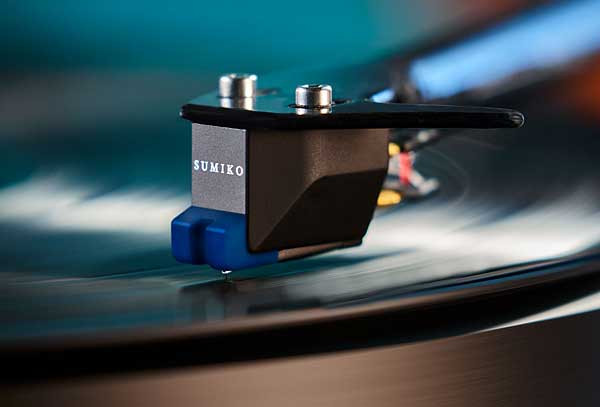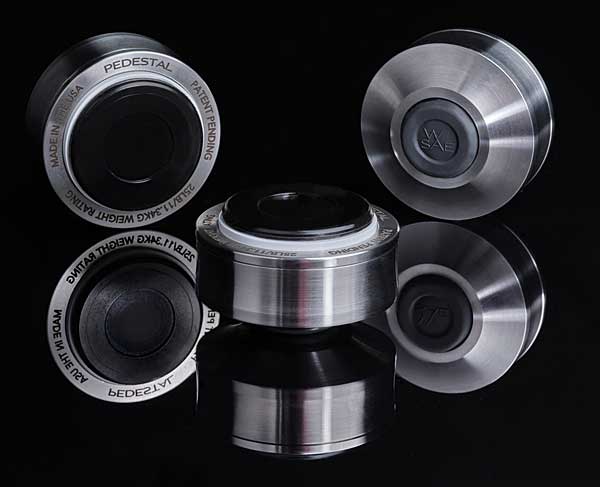| Columns Retired Columns & Blogs |
I use quality medical-grade hemostats and tweezers for working on the TT arm and cartridge.
What about the Balanced edition? It replaces both the choke at the anode input and the capacitor at its output with center-tapped output transformers; the output transformer provides for true-balanced output (footnote 5). Other differences: In the "Balanced" version, 6S45P triodes replace the EL84 pentode tubes, and a 5Y3 replaces the 5U4GB rectifier tube; I think that's the rectifier tube in my Fender guitar amp. In addition, there are some optional upgrades: silver wiring and silver-wired output transformers, Bakelite circuit boards, Black Gates in the power supply, and so on.
The LPU III includes two pairs of RCA inputs (one of which is for use with mono cartridges) plus a stereo input on a single XLR connector, made to fit SW1X's special tonearm cable. There are three output pairs: one single-ended stereo RCA, one single-ended mono RCA, and one XLR pair, which in my sample was not true balanced (see footnote 5) but normally would be. The input and output sets are wired "in parallel" and always on.
The LPU III's circuitry is housed in a full-sized chassis, 5.5" high, 17" wide, and 16" deep. The LPU III Balanced weighs 25lb. Only minimal specifications are provided: The output impedance is <20 ohms. "Output noise" is ;0.5mV RMS, unweighted. These specs are "subject to change without notice." For people who care about specifications, it's not much to go on, but SW1X products are not about specifications. This designer is going for a particular sound based on sonic concepts and preferences.

When I auditioned the LPU I, I summed it up this way: "It's a high value, smartly designed, classic, 'purist,' vacuum tube–based MM phono preamp that achieves all of the positive things such circuits can offer—especially timbral and textural generosity and transient delicacy—at a very reasonable price, while avoiding pitfalls such as noise, limited bandwidth, soggy bass, and constricted dynamic range. It's a sweet-sounding phono preamp, great for jazz, classical, and acoustic music. If you're mostly a rocker, you're better off with silicon. That's just the way it is."
The LPU III Balanced costs about three times what the LPU I cost. According to the designer, it's "the most transparent" of all the circuit iterations. Is it? With more than a year between auditions, I'd be foolish to say yes or no, and you'd be foolish to believe me. But I did what I could to make the auditions equivalent. For example, I used the same cartridge/SUT combos I used in the original review: the Miyajima Labs Infinity for mono, the Lyra Atlas Lambda SL for stereo, both run into the Ypsilon MC10 SUT. (An exception: The Bob's Devices Cinemag Sky 20 had been returned to the manufacturer.) I listened to some of the same records.
Enter the Sumiko WellFleet: But before I set that up, the $449 Sumiko Wellfleet moving magnet cartridge was mounted on the J.Sikora arm and 'table I'd been listening to, having the ride of its life. The Wellfleet's output was EQ'd and amplified by the $672 QHW "The Vinyl" MM/MC phono preamp (which should have won Budget Product of the Year last year in my opinion) or, alternately, the new $149 Schiit Mani 2 MM/MC phono preamplifier (about which, see my review at Analog Planet).

I doubt that anyone buying the LPU III Balanced will pair it with a $449 MM cartridge, but the LPU III evinced the Wellfleet's most attractive qualities, especially in the mid and upper frequencies, where see-through transparency, transient clarity, and precision—completely free of edgy artifacts, grain, and grit—produced a bubble of pleasure my ears wanted to sink into and did, for hours.

Moving to the Infinity cartridge and playing the Record Store Day mono edition of Chet Baker Sings (It Could Happen to You) (Riverside/Craft Recordings CR00243) produced the same subtle microdynamic vocal shifts I heard with the LPU I, creating the sensation of hearing Baker from the other side of the microphone.
I used the LPU III to compare the new One-Step "Small Batch" Craft reissue of Relaxin' with the Miles Davis Quintet (Prestige/Craft Recordings CR-00227) to a clean original pressing (Prestige 7129) and to the 2002 double-45 edition cut by Kevin Gray for Analogue Productions (AJAZ 7129). The LPU III clearly showed the similarities and differences among these issues—but for the results of that comparison, you'll need to visit AnalogPlanet.

I know the album is unobtanium, but the LPU III and the Electric Recording Company's "true mono" edition of John Coltrane's Giant Steps (Atlantic/Electric Recording Company ERC 059) provided, in one sitting, a year's worth of musical and sonic pleasure.

A Belgium-based producer named Tom Callens sent me two new, all-analog records he has produced, both by the "Gen-X" conservatory-trained septet Lester's Blues. Radio Rhythm (Sing My Title SMT-033LPA), which was just released, was recorded live to analog tape with all seven musicians standing around a single, AEA R88 stereo microphone, in which two ribbon transducers are fixed in a Blumlein configuration (footnote 6). The records were mastered and cut to lacquer by Rainer Maillard at Emil Berliner Studios in Berlin. Radio Rhythm was produced in a run of just 300 copies. You can order the two records at Bandcamp, assuming they are not sold out by the time you read this.
The LPU III's transparency and 3D presentation made me feel like I'd been pulled right into the room where the group performed. The phono preamp's airy and convincing spatial staging was matched by its delivery of well-saturated, natural instrumental timbres with rhythm'n'pacing and "punch" to spare. On "Easy Living," vocalist Delphine Gardin chimes in believably right there—fast, clean, edge- and grain-free with the room acoustic providing a natural, realistic backdrop. These recordings were made for the LPU III; I hope Dr. Roschkow gets to hear them.
My reference, the solid state CH Precision P1, with the X1 power supply, produced a different but equally pleasing sensation, the musical event occurring well back in space from where the LPU III placed it. While the colors were somewhat muted and the three-dimensionality less exuberant, the imaging and soundstaging solidity produced an equally convincing picture, though with noticeably less air. That was compensated for by the P1/X1's bottom-end weight and solidity, which had me concluding, as I did for the LPU I, that while the SW1X LPU III is easy to recommend for classical and acoustic jazz, rockers in need of full electric bass extension and transient grip should look elsewhere.

Aiming to address that deficiency, I placed a trio of Wilson Audio Specialties Pedestals, and then a quartet of Lehmann Audio 3S feet, under the LPU III chassis, which is not especially rigid. Both sets of footers noticeably improved bass focus, though not extension. If you buy any LPU, I'd recommend investing in some good feet!
If you don't like the LPU I, you won't like the LPU III. If you like the LPU I, you'll also like the LPU III. I certainly did, and the added mono input is great for mono fans.
Is the LPU III Balanced worth three times what the LPU I costs? As I said earlier, I auditioned the two products a year apart, so I really don't know. In some ways, Dr. Roschkow's healthy obsession with this basic circuit design, which he offers in so many colors, flavors, and options, reminds me of the late Bobby Palkovic of Merlin Music Systems, who over the years refined his VSM loudspeaker almost to the point of obsession. Each refinement delivered incremental improvements to what was already a wonderful-sounding speaker. Ultimately, though, it was the same two-way box. Dr. Roschkow is doing something similar with his LPU.
Maybe the best choice is somewhere in between. If you are considering the LPU I, don't go for the least expensive version. I take the doctor at his word when he says choke-loading the anodes makes conventional resistor-loaded circuits sound "lame and dull in comparison." The LPU I he sent me for review was resistor-loaded. If you have a chance to hear either that one or the LPU III Balanced, there's little chance you'll find it "lame and dull."
OMA K3, Bye Bye
Today, the OMA K3 turntable, which has been providing great musical pleasure here for more than a year, exited the building. I can't afford it even at an accommodation price. If I could, I'd buy it in a heartbeat.
Ever since it was delivered for review more than a year ago, it has performed flawlessly, with no tweaking or adjusting of any kind other than cartridge changes, and those were made pleasurable by Frank Schröder's ingenious arm design. The original Xenon rectifier tube continues its purple dance behind glass. This turntable had a great deal of use.
Will I miss it? Maybe not, because it has been replaced by the prototype K3 that was here before the production unit arrived. The prototype is mechanically and sonically identical to the production version, different only in some cosmetics. OMA's Jonathan Weiss kindly spruced it up with a new, flat black paint job. I think I like this "punk" look better.
This version I can afford, and I'm buying it. The less-costly OMA K5 will soon make its debut. I look forward to reviewing that one, too.
Footnote 6: The first Lester's Blues record, which was released in 2018, wasn't quite as purist. For that one, each musician had a microphone, and the feeds were mixed live, on the fly, to two-track analog tape. To purchase the records (or the download, or the same music on CD), visit lestersblues.bandcamp.com.

I use quality medical-grade hemostats and tweezers for working on the TT arm and cartridge.

The ever affable Wally Malewicz many yeas ago gifted me with a lovely little set of assembly pliers that he had expertly modified just to deal with phono cartridge pins and clips. JR at WAM Engineering might need to offer these for sale!

Hi
Why using pentodes for phonostage instead of triodes which are far more quieter than pentodes ! Low noise is crucial for phonostage when the cartridge output signals is soooo low ! Besides, triodes are truly LINEAR while pentodes are not !
Trioded pentodes indeed reduces the gain of the phonostage, but pentode noise is still the issue.
Listening is believing
Jack L

Michael,
Decades ago when I was in College we talked about balanced vs un-balanced. Transformers outputs (unless one side grounded) are always balanced. Heck the original specification as I read it in the Peerless/Altec app note said that balanced connection had no connection to ground. So the need to ground the center tap to make a balanced connection is not really required. For that matter that probably means any solid state or tube direct out that is balanced probably is incorrect. The whole idea of using a balanced non-grounded setup was that the output could float to the receiving sides ground and therefore reduce the DC voltage between the two units. Most Pro tube stuff I design do have a center tap and I include a switch for ground, cap coupled ground or float the secondary.
Thanks,
Gordon

Hi
Yes, "direct out" is single-out, unbalanced.
To get differential-out or balanced out, an isolation audio transformer is neeed to convert the single-ended unbalanced ouput signals to differential balanced output signals.
Centre-tapping of the transformer is not needed as long as the grounding wire of the sending component is connected to the ground wire of the receiving end.
Jack L

How come Mike's speaker types have been MIA in the "Associated Equipment" in recent reviews [ie. Gryphon Amp]?

How come Mike's speaker types have been MIA in the "Associated Equipment" in recent reviews [ie. Gryphon Amp]?
The speakers are listed in the on-line reprints of his reviews. For example, see www.stereophile.com/content/gryphon-commander-line-preamplifier-associated-equipment.
John Atkinson
Technical Editor, Stereophile

You are, of course, correct - but why not in the actual print magazine that I subscribe to?
I know—ending a sentence with a preposition and all!